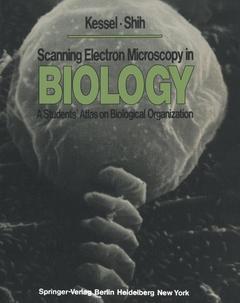Scanning Electron Microscopy in BIOLOGY, Softcover reprint of the original 1st ed. 1976 A Students' Atlas on Biological Organization
Langue : Anglais
Auteurs : Kessel R.G., Shih C.Y.

In the continuing quest to explore structure and to relate struc tural organization to functional significance, the scientist has developed a vast array of microscopes. The scanning electron microscope (SEM) represents a recent and important advance in the development of useful tools for investigating the structural organization of matter. Recent progress in both technology and methodology has resulted in numerous biological publications in which the SEM has been utilized exclusively or in connection with other types of microscopes to reveal surface as well as intracellular details in plant and animal tissues and organs. Because of the resolution and depth of focus presented in the SEM photograph when compared, for example, with that in the light microscope photographs, images recorded with the SEM have widely circulated in newspapers, periodicals and scientific journals in recent times. Considering the utility and present status of scanning electron microscopy, it seemed to us to be a particularly appropriate time to assemble a text-atlas dealing with biological applications of scanning electron microscopy so that such information might be presented to the student and to others not yet familiar with its capabilities in teaching and research. The major goal of this book, therefore, has been to assemble material that would be useful to those students beginning their study of botany or zoo logy, as well as to beginning medical students and students in advanced biology courses.
1 Introduction.- Comparison of the Scanning Electron Microscope with Other Microscopes.- Basic Theory and Operation of the Scanning Electron Microscope.- Modes of Operation of the Scanning Electron Microscope.- Methods of Specimen Preparation in Scanning Electron Microscopy.- 2 One-Celled Organisms.- Ciliate Protozoa.- Flagellate Protozoa.- Amoeboid Protozoa.- 3 Cells in Culture.- Surface Specializations.- Variations in Cell Surface Specializations.- Cells in Mitosis.- Chick Embryo Chondroblasts.- Phagocytosis by Normal and Abnormal Tissue Culture Cells.- Induced Morphogenesis of Glial Cells.- 4 Prokaryotes.- Bacteria.- Blue-green Algae.- 5 Fungi and Algae.- Slime Molds.- Fungi.- Algae.- 6 Multicellular Plants.- Liverworts and Mosses.- Lower Vascular Plants.- Gymnosperms.- 7 Organ Systems of Angiosperms.- Roots.- Shoot Apex.- Stem.- Leaf.- Flower.- Seed.- 8 Multicellular Animals.- Sponges.- Hydra and Other Coelenterates.- Flatworms.- Spiny-headed Worms.- Nematodes.- Ectoprocts or Lophophorate Coelomates.- Annelid Worms.- Molluscs.- Arthropods.- 9 Tissue and Organ Systems of Animals.- Blood.- Muscle Tissue.- Digestive System.- Respiratory System.- Excretory System.- Male Reproductive System.- Female Reproductive System.- Sense Organs.- 10 Development.- Fertilization and the Cortical Reaction in Sea Urchins.- Embryology of the Frog.
Date de parution : 01-2012
Ouvrage de 348 p.
20.3x25.4 cm
Disponible chez l'éditeur (délai d'approvisionnement : 15 jours).
Prix indicatif 105,49 €
Ajouter au panierThème de Scanning Electron Microscopy in BIOLOGY :
© 2024 LAVOISIER S.A.S.


